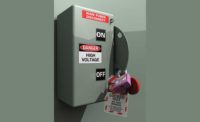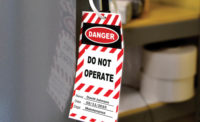Go with a plan
“A LOTO plan must include a clear distinction between online adjustment and offline maintenance. The choice of when to apply LOTO must not rest with the equipment operator. One-size-fits-all LOTO plans only work with similar equipment. Canned LOTO plans are generally too vague to serve as anything other than a guide for further refinement. Every system and piece of equipment should get its own separate LOTO plan,” said Arthur Zatarain, PE, a board certified forensic engineer.
OSHA regulations put the federal standard, 1910.147, in place in 1989. While the purpose of LOTO has not changed, equipment complexity has increased. With PLC linked interlocks, remote computer controls, light curtains, automatic valves, and other machine automation accessories commonplace, both workers and facility managers need to be kept up to speed.
“Feel-good sentiments such as ‘all employees shall be properly trained’ become fodder for large settlements when the term ‘properly’ is put before a jury. Better to design LOTO plans that include specific training content and frequency, stick to it, and then verify the training with testing and signed documentation,” added Zatarain.
Even the best LOTO programs can have problems if there’s no plan for sustainability — updating procedures when machines are moved, changed or added. To keep the plan dynamic:
- Use MS Word, Excel or a prepackaged LOTO software system for documentation, and assure that key personnel have a copy so they can edit as needed
- Enlist consultants to create and monitor LOTO programs and conduct audits for an unbiased perspective
- Use tablets and smartphones to maintain plant-wide communications
Select the right products
Rather than ordering signage, many are opting to use industrial labeling systems to create site-specific signs and labels on demand.
Advances in labeling supplies include:
- Tapes that stand up to oil, chemicals, extreme temps and outdoor conditions
- Magnetic and removable labels
- Glow-in-the-dark or photoluminescent labels for emergency situations or power outages
Lockout devices are used to protect employees and the environment from stored hazardous energy from pressure, temperature or contents of a pipe or vessel. They are also used to control current to electrical devices. Hasps, chains or cable, or other types of lockable devices make it easier for employees to both lock out equipment and also to see that the equipment has been disabled for maintenance or some other reason. Lock boxes make it easier to place locks on several pieces of equipment at the same time or for more than one employee to place locks on the equipment at the same time.
Energy storage systems can be broadly categorized as mechanical, electrical, chemical, biological and thermal. Many machines in industrial settings are powered electrically. Their current may be controlled by capacitors or batteries. Modern machinery may contain many hazards to workers from electrical, mechanical, pneumatic and hydraulic sources. For example, a typical industrial machine at a food processing plant may have hot fluids, moving presses, blades, propellers, electrical heaters, conveyor belts with pinch points and moving chains.
“In the steel coil processing industry, we use all types of LOTO equipment. We do all our own hydraulic and pneumatic piping so we use ball valve lockouts to protect from pressurized lines. All our employees are LOTO trained and given lockouts with company name and employee names visible,” said Ryan Rockhold, PCIS.
Main causes
The five main causes of LOTO injuries, according to the Oklahoma State University EHA:
- Failure to stop equipment
- Failure to disconnect from a power source
- Failure to dissipate residual energy
- Accidental restarting of equipment
- Failure to clear work areas before restarting
Final recommendations
- Follow hazardous energy control program regulations.
- Complete training on hazardous energy control procedures.
- Ensure before beginning any adjustment, maintenance or servicing work, that all sources of hazardous energy are de-energized.
- Insist that all forms of hazardous energy, including electrical breaker panels and control valves are properly locked and tagged; and all stored energy sources are blocked or dissipated.
- Verify only one key exists for each of your assigned locks and only you hold that key.
- Test to ensure all energy sources are de-energized.
Keep these principles top of mind. You’ll be rewarded with assurance that everyone returns home safely after each and every shift.



